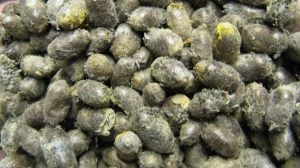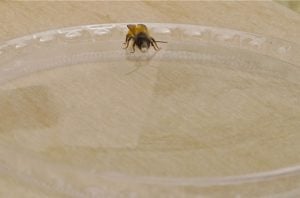I’ve always been interested in bees and thirty years ago I took part in a red-tailed bumblebee (Bombus lapidarius) study in an attempt to map their presence. I was a lot younger then and I sprinted over walls and chased up and down dale trying to find their nests in rural Northamptonshire, with limited success. However those early bee hunts taught me a thing or two and I’ve learnt that you can’t go by size when it comes to bumblebees. You need to look at the markings, the bars and hairs, because colonies build up slowly when food supplies allow. The first bees out of the nest can be much smaller than those emerging in June, say, when nectar and pollen are in greater abundance.
I spend many a happy hour watching bumblebees feed on flowers and red tails are particularly fond of our native blue cornflower, Centaurea cyanus, so I always plant plenty. I raise some seeds in March, in modular trays, and also sprinkle some self-saved seeds about once the weather is warm, in late-May. Their flowers always attract red tails and, if you dead head them, they flower for months. A few years ago I had a nest right underneath the study window and saw several queens appear. Sadly bees never return to a used site because of the mite problem.
I grow early-spring flowers too, such as hellebores, crocus and pulmonaria, because some bumblebee queens emerge early and they need nectar and pollen in order to survive and breed. The first to appear is usually Bombus terrestris, the buff-tailed bumblebee. Large queens can be seen as early as January in some years, zigzagging over the ground in their hunt for a suitable nest site. Bumble bees are capable of flying early because they can rev up their flight muscles chemically and this allows them to fly in much lower temperatures. They browse between flowers, from cowslip to bluebell for instance, and they have an ability to buzz pollinate sticky pollen by vibrating and shaking the pollen down. The solanum family, which includes peppers and tomatoes, can only be pollinated by bumblebees.
It’s no secret that bumblebees are in decline and the Bumblebee Conservation Society www.bumblebeeconservation.org, established in 2006, is a great charity to subscribe to. It has a seriously informative website too, with distribution maps and line drawings. In all Britain and Ireland have 24 native species and fifteen are in serious decline and seven are so threatened that they are now designated a UK Biodiversity Action Plan species. Three are thought to be extinct already. Eight species are likely to be seen in gardens.
Some of our most threatened species were really plentiful in the past, so much so that entomologists rarely bothered to record their presence in their accounts right up until the Second World War. The shrill carder bee ( Bombus sylvarum) was described as “everywhere as usual” according to Hallet writing in 1928 and was still about when Free and Butler (writing in 1959) recorded their findings. However Alford (writing in 1975) was unable “to give first-hand accounts for many of them” and by 2005, when Edwards and Jenner wrote The Field Guide to the Bumblebees of Great Britain they only recorded 2 shrill carder bees in “6 person-weeks of searching.”
Not having enough bees is a serious thing and in south-west China they have to hand pollinate their crops with paint brushes and pots of pollen because their bees are almost non-existent. In America the Natural Resources Defence Council ( www.nrdc.org) recorded that “42 percent of U.S. bee colonies collapsed in 2015, well above the average 31 percent that have been dying each winter for nearly a decade.” They attribute this devastating decline “to the skyrocketing use of dangerous pesticides called neonicotinoids, or neonics.”
Britain has many solitary bees, besides bumblebees, so I was very interested to find out about the red mason bee ( Osmia bicornis), a native solitary bee found naturally in lowland England and Wales. This tremendous pollinator is calculated to be between 120 and 200 times better than the honey bee because like many solitary bees it doesn’t have any pollen sacs. The sticky pollen is deposited on the furry underside of the body, suspended like a yellow magic carpet, and whenever these swiftly moving bees enter a flower, pollen is transferred to the next and so on, in the blink of an eye.

Chris Whittles supplies red mason bees to commercial fruit growers for pollination purposes ( www.masonbees.co.uk). Gardeners can become bee guardians and he has supplied me with 30 cocoons and a nest box with tubes. For the last four weeks or so I have been anxiously watching them emerge in their see-through plastic tub, but it’s been so cold that I’ve had to keep the unhatched cocoons in my warm kitchen. I’m hoping that they will navigate back home.
I’ve noticed that the males seem to emerge first. They are smaller, with a yellow tuft of hair on their faces, and they don’t seem very keen to get going and I don’t blame them with the weather we’ve had. However when a female emerges, it’s twice the size and very anxious to get going. There’s an analogy there, ladies, and it reminds me of the time I tried to buy the Best Beloved a Simon Drew teeshirt bearing the words Procrastination is the Chief of Swine. It had sold out quickly, they explained, because procrastination is a fine art among males and not just bees!

Chris Whittles told me that red mason bees spend their first two weeks playing and mating. Yesterday was a little warmer and one or two bees were investigating the tubes so we live in hope. They are apparently superb at pollinating fruit and eventually my apple trees will blossom and hopefully I’ll get a bumper crop from ‘D’Arcy Spice’ and ‘Pitmaston Pineapple’. In the meantime there are three cocoons left so I’m still clucking about like a mother hen.
If all goes well, the tubes will be full of baby bees and the ends will be capped in mud. These will be sent back to Chris in the autumn and he will empty and clean the tubes and then send me back some more cocoons next March. Last year one champion bee guardian, who placed his nesting box and tubes on a warm south wall just as we have, sent back 1800 cocoons – so I’m hoping to do quite well!



